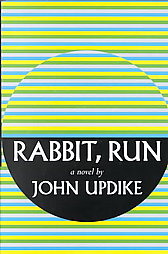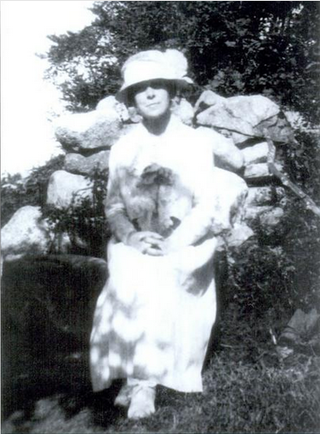Related Research Articles

John Hoyer Updike was an American novelist, poet, short-story writer, art critic, and literary critic. One of only four writers to win the Pulitzer Prize for Fiction more than once, Updike published more than twenty novels, more than a dozen short-story collections, as well as poetry, art and literary criticism and children's books during his career.

Elizabeth Bishop was an American poet and short-story writer. She was Consultant in Poetry to the Library of Congress from 1949 to 1950, the Pulitzer Prize winner for Poetry in 1956, the National Book Award winner in 1970, and the recipient of the Neustadt International Prize for Literature in 1976. Dwight Garner argued in 2018 that she was perhaps "the most purely gifted poet of the 20th century". She was also a painter, and her poetry is noted for its careful attention to detail; Ernest Hilbert wrote “Bishop’s poetics is one distinguished by tranquil observation, craft-like accuracy, care for the small things of the world, a miniaturist’s discretion and attention."

Ipswich is a coastal town in Essex County, Massachusetts, United States. The population was 13,785 at the 2020 census. Home to Willowdale State Forest and Sandy Point State Reservation, Ipswich includes the southern part of Plum Island. A residential community with a vibrant tourism industry, the town is famous for its clams, celebrated annually at the Ipswich Chowderfest, and for Crane Beach, a barrier beach near the Crane estate. Ipswich was incorporated as a town in 1634.
Montserrat College of Art is a private, non-profit art college located in Beverly within Essex County of Massachusetts. The school is accredited by both the New England Commission of Higher Education and the National Association of Schools of Art and Design.
Merrymount Press was a printing press in Boston, Massachusetts, founded by Daniel Berkeley Updike in 1893. He was committed to creating books of superior quality and believed that books could be simply designed, yet beautiful. Upon his death in 1941, the Press was taken over by his partner John Bianchi, but ceased operations in 1949. Updike and his Merrymount Press left a lasting impression on the printing industry, and today Updike is considered one of the most distinguished printers of the twentieth century. Stanley Morison, the typographer responsible for creating the ubiquitous Times New Roman, had this to say of the Merrymount Press after Updike's passing: “The essential qualities of the work of the Merrymount Press...may be said without exaggeration…to have reached a higher degree of quality and consistency than that of any other printing-house of its size, and period of operation, in America or Europe.”

Rabbit, Run is a 1960 novel by John Updike. The novel depicts three months in the life of a 26-year-old former high school basketball player named Harry "Rabbit" Angstrom, who is trapped in a loveless marriage and a boring sales job, and attempts to escape the constraints of his life. It spawned several sequels, including Rabbit Redux, Rabbit is Rich and Rabbit at Rest, as well as a related 2001 novella, Rabbit Remembered. In these novels, Updike takes a comical and retrospective look at the relentless questing life of Rabbit against the background of the major events of the latter half of the 20th century.

Selma Hortense Burke was an American sculptor and a member of the Harlem Renaissance movement. Burke is best known for a bas relief portrait of President Franklin D. Roosevelt which may have been the model for his image on the obverse of the dime. She described herself as "a people's sculptor" and created many pieces of public art, often portraits of prominent African-American figures like Duke Ellington, Mary McLeod Bethune and Booker T. Washington. In 1979, she was awarded the Women's Caucus for Art Lifetime Achievement Award. She summed up her life as an artist, "I really live and move in the atmosphere in which I am creating".

Couples is a 1968 novel by American author John Updike.
Elizabeth Howe was one of the accused in the Salem witch trials. She was found guilty and executed on July 19, 1692.
Molly Fisk is an American poet and radio commentator. She has been teaching writing since 1994 and runs the on-line workshop Poetry Boot Camp. Her most recent book is Naming Your Teeth: Even More Observations from a Working Poet. She was honored as an Academy of American Poets Laureate Fellow in 2019.
Hortense (Golden) Canady was a civil rights leader, the first African American elected to the Lansing Board of Education. She served as national president of Delta Sigma Theta sorority from 1983-1988.

The literature of New England has had an enduring influence on American literature in general, with themes such as religion, race, the individual versus society, social repression, and nature, emblematic of the larger concerns of American letters.

Mary Brewster Hazelton was an American portrait painter. She attended the School of the Museum of Fine Arts, Boston, where she was later an instructor. Among her other achievements, Hazelton was the first woman to win an award open to both men and women in the United States when she won the Hallgarten Prize from the National Academy of Design in 1896. Her portrait paintings are in the collections of the Massachusetts State House, Harvard University, Peabody Essex Museum, and Wellesley Historical Society. The professional organizations that Hazelton was affiliated with included the Wellesley Society of Artists, of which she was a founding member, and The Guild of Boston Artists, of which she was a charter member. She lived her adult life with her sisters in the Hazelton family home in Wellesley, Massachusetts.
Sarah Updike Goddard was an early American printer, as well as a co-founder and publisher of the Providence Gazette and Country Journal, the first newspaper founded in Providence, Rhode Island. She worked closely with her son William and daughter Mary Katherine, who both also became printers and publishers, forming one of the earliest influential publishing dynasties in the American colonies.

Charles Herbert Moore was an American university professor, painter, and architectural historian, known as the first director of Harvard University's Fogg Art Museum. Initially he was one of many followers of the works of John Ruskin, and was known as an American Pre-Raphaelite. But later he would abandon Ruskin to follow the teachings of the french architect Viollet le Duc.
Elizabeth Updike Cobblah is an American art teacher and ceramicist, painter, and illustrator in Massachusetts. She is the eldest child of author John Updike, and was the model for several of his characters. She is married to Tete Cobblah.
Martha Franc Ruggles Bernhard Updike was an American social worker and the widow of author John Updike. She served as a model for several of his fictional characters, including in his story "A Constellation of Events", which was loosely based on the initiation of their relationship.
David Updike is an American writer and academic. Updike is the son of author John Updike, who used him as a model for characters in several works of fiction, including Wife-wooing, Avec la Bebe-sitter, Son, and Separating.

Linda Grace Hoyer Updike (1904–1989) was an American writer from Plowville, Pennsylvania. She was the mother of writer John Updike and grandmother of writer David Updike. Linda Updike also served as the model for several of her son's characters, including one of the main characters in the novel Of the Farm.

Problems and Other Stories is a collection of 23 works of short fiction by John Updike. The volume was published in 1979 by Alfred A. Knopf. The stories were first carried in literary journals, 17 of which appeared in The New Yorker. Problems and Other Stories is one of two collections of Updike's short stories that appeared in 1979.
References
- ↑ Atlas, James (1978-12-10). "JOHN UPDIKE BREAKS OUT OF SUBURBIA". The New York Times. ISSN 0362-4331 . Retrieved 2024-07-04.
- ↑ Adam Begley, Updike (Harper Collins: 2014)
- 1 2 3 4 "Mary Weatherall Obituary (1930 - 2018) - Ipswich, MA - Chronicle & Transcript". Legacy.com. Retrieved 2024-07-04.
- ↑ "David Updike on Growing up Updike | THE JOHN UPDIKE SOCIETY". 2015-04-12. Retrieved 2024-07-04.
- ↑ John Updike, Self-Consciousness (2012) https://books.google.com/books?isbn=0812982967
- ↑ Jack De Bellis, The John Updike Encyclopedia, (2000) p. 474
- ↑ "Robert Weatherall Obituary (2015) - Ipswich, MA - Chronicle & Transcript". Legacy.com. Retrieved 2023-07-06.
- ↑ "Collection: Papers of Mary Pennington Updike Weatherall, 1893-2018 | HOLLIS for".